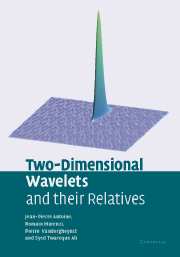Book contents
- Frontmatter
- Contents
- Prologue
- 1 Warm-up: the 1-D continuous wavelet transform
- 2 The 2-D continuous wavelet transform
- 3 Some 2-D wavelets and their performance
- 4 Applications of the 2-D CWT. I: image processing
- 5 Applications of the 2-D CWT. II: physical applications
- 6 Matrix geometry of wavelet analysis. I
- 7 Matrix geometry of wavelet analysis. II
- 8 Minimal uncertainty and Wigner transforms
- 9 Higher-dimensional wavelets
- 10 Spatio-temporal wavelets and motion estimation
- 11 Beyond wavelets
- Epilogue
- Appendix: Some elements of group theory
- References
- Index
11 - Beyond wavelets
Published online by Cambridge University Press: 19 August 2009
- Frontmatter
- Contents
- Prologue
- 1 Warm-up: the 1-D continuous wavelet transform
- 2 The 2-D continuous wavelet transform
- 3 Some 2-D wavelets and their performance
- 4 Applications of the 2-D CWT. I: image processing
- 5 Applications of the 2-D CWT. II: physical applications
- 6 Matrix geometry of wavelet analysis. I
- 7 Matrix geometry of wavelet analysis. II
- 8 Minimal uncertainty and Wigner transforms
- 9 Higher-dimensional wavelets
- 10 Spatio-temporal wavelets and motion estimation
- 11 Beyond wavelets
- Epilogue
- Appendix: Some elements of group theory
- References
- Index
Summary
Up to now, we have developed the 2-D CWT and a number of generalizations, relying in each case on the group-theoretical formalism. Given a class of finite energy signals and a group of transformations, including dilations, acting on them, one derives the corresponding continuous WT as soon as one can identify a square integrable representation of that group.
On the other hand, we have also briefly sketched the discrete WT and several transforms intermediate between the two. One conclusion of the study is that the pure DWT is too rigid, whereas redundancy is helpful, in that it increases both flexibility and robustness to noise of the transform. Indeed, the wavelet community has seen in the last few years a growing trend towards more redundancy and the development of tools more efficient than wavelets, such as ridgelets, curvelets, warplets, etc. The key word here is geometry: the new transforms and approximation methods take much better into account the geometrical features of the signals. To give a simple example, a smooth curve is in fact a 1-D object and it is a terrible waste (of times or bits) to represent it by a 2-D transform designed for genuine 2-D images.
It is therefore fitting to conclude the book by a chapter that covers these new developments.
- Type
- Chapter
- Information
- Two-Dimensional Wavelets and their Relatives , pp. 373 - 412Publisher: Cambridge University PressPrint publication year: 2004



